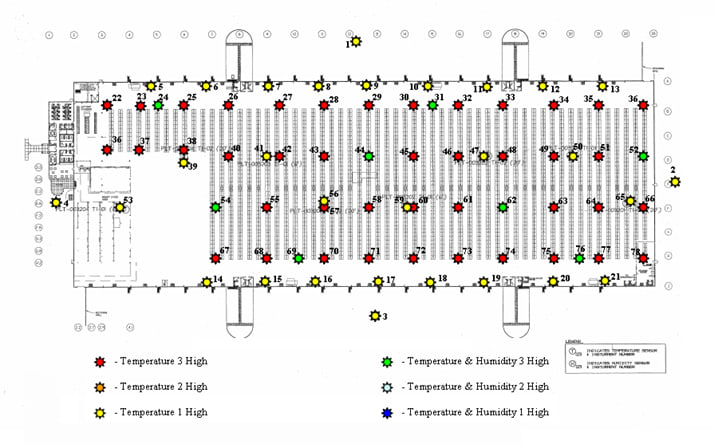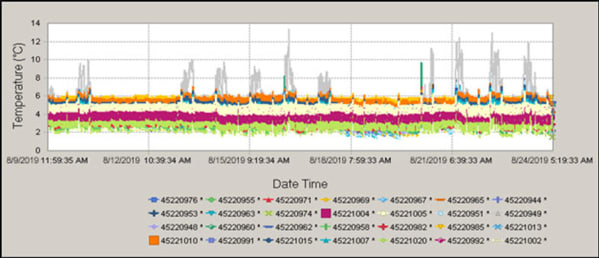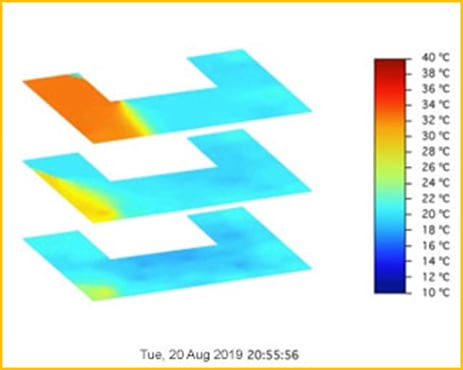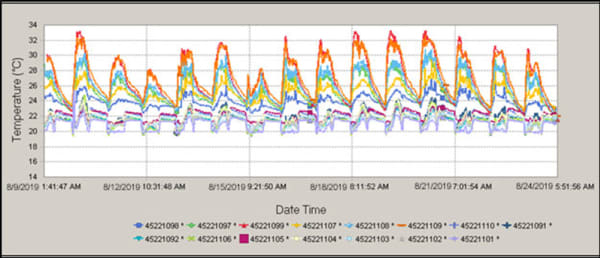Thermal Mapping Case Study: A Critical Component for Temperature Control
Meet Cold Storage Regulatory Requirements Using Data-Driven Thermal Analysis

Global life sciences regulatory and standards-based guidance for the storage of temperature-sensitive medicinal products recommends that facilities used to hold medicinal products be thermally mapped. A thermal mapping analysis defines the facility’s worst case temperature positions to prove proper placement of permanent temperature sensors. Thermal mapping comes with the expectation that a company’s quality management system will appropriately document that a state of control can be maintained.
Sensitech Professional Services brings decades of thermal mapping expertise, working with customers to provide evidence-based insights that support a company’s implementation of a permanent stationary monitoring protocol and document their compliance in meeting life sciences regulations. Data is at the core of meaningful and measurable related insights that can help identify systemic weaknesses and variability in cold chain processes, and isolate problems before they occur.
Each thermal mapping study provides an extensive report based on data from TempTale® devices, which will support an audit, demonstrating proper monitoring due diligence and protocols for each facility or piece of equipment. Our Professional Services team adds further analysis that transforms raw data into actionable information. Below is one case study in which Sensitech’s analysis provided more than guidance and documentation for proper sensor placement, resulting in improved temperature management across the facility.

Determining Placement Using Data
A large pharmaceutical customer required storage monitoring data that would allow them to bring their warehouse environment into specification without frequent temperature excursions. Additionally, the customer required a documented process to demonstrate their control of the temperature in their facility. They used Sensitech Professional Services to conduct a thermal mapping study, with the goals to provide:
- Permanent ColdStream® Site sensor placement recommendations to allow accurate temperature monitoring and enable confidence in the environment’s set point temperature
- Audit-ready documentation that the warehouse environment was in specification
Thermal mapping demonstrates control of a storage environment by placing temporary sensors throughout a facility, trailer or storage equipment to identify its worst-case positions—those that are subject to temperature fluctuations or prone to excursions. The resulting data allows a facility to install monitoring sensors in positions that ensure accurate temperature monitoring, with testing and processes documented to ensure quality compliance.
Sensitech Professional Services ranks all positions monitored using TempTale devices during the thermal mapping based on severity of temperature control and uses this ranking to define the best locations for permanent monitoring with the ColdStream Site system. At the end of a mapping, customers are provided with a detailed report that turns raw data into actionable information for ongoing temperature management.
Patterns Uncovering Unknown Problems
The thermal mapping process took place over a two-week period during the summer. Regulators require studies in summer and winter, and evidence supports that a two-week period is the ideal timeframe to account for both procedural operations that can affect temperatures within an active storage facility and external weather variations that may influence internal temperatures.
This scenario provided detailed data including:
- Three-dimensional temperature mapping of the warehouse and its cold room
- Analysis of frequent low temperature excursions
- Impact of regular high temperature excursions
Sensitech’s continuous two-week study provided full line-of-sight into the ways active workers affected the internal temperature of the customer’s cold room, as well as a more complete understanding of the external weather variables’ impact on the warehouse interior temperature. In this unusual case, this storage environment had both hot and cold excursions occurring concurrently in close proximity. Both issues had been observed by the customer, but the root causes had not been identified.
Extensive cold chain expertise enabled the build out of a reliable protocol for this environment. The team determined the quantity of sensors necessary for its size and layout, and divided the sensors and areas into low, medium and high placements depending on height to account for the three-dimensional space.

TempTale sensor placement plan to thermal map the customer’s warehouse
Sensitech positioned sensors in a grid pattern throughout the warehouse and cold room storage spaces, with a focus on geometric extremes and locations most prone to temperature deviations. Because Sensitech manufactures its own sensors, the placement was granular and specific to allow deeper analysis into factors such as how stored products’ positioning might impede airflow.
Regulations require that environments with adjoining external walls also account for external temperature influence. In order to get a full picture of this outside weather influence, Sensitech placed sensors on the exterior of the building to monitor daily external temperature changes.
Unlocking Good Temperature Management
A procedural issue was the first major contributor to fluctuations across the facility. Sensor data identified a recurring temperature incursion when the cold room’s door was opened, allowing hot air into the cold room and causing cold air to circulate into the warehouse storage environment. Patterns suggested the cold room door was not being opened and closed normally, but left ajar as people worked, unaware that they were bringing the two storage environments out of their temperature specifications.

Cumulative cold room temperature data demonstrated high peaks during the work week, and temperatures that ran too cold on weekends, indicating poor open door management and an incorrect set point.
The cumulative sensor graph shows the cold room temperatures over time. The sensors closest to the doors show a “work schedule” result, in which the temperature peaks correlate with eight-hour work days and five-day work weeks. The lower end of the graph illustrates that the environment’s set point was too low. This resulted in a combination of too-cold temperatures in the cold room broken up by heat incursions from poor open door management.

Hot airflow (top left) circulating in close proximity to a cold excursion (bottom middle) outside the storage environment’s cold room.
The data also discovered that this customer’s warehouse storage environment had a recurring problem with high temperature air circulation just a few meters away from the cold room.

In the graph above, temperature variations correlate with the daily weather cycle. Investigating the location of the heat incursion from our three-dimensional analysis, the customer discovered that the insulation within the western wall had suffered damage the previous year. External temperature conditions were affecting the warehouse, with temperatures rising at the hottest parts of the day and falling during the coldest parts of the night.
Turning Data into Information, into Action
Sensitech’s thermal mapping service recommended ideal permanent sensor placement positions with supporting regulatory documentation and provided the information needed to improve the facility’s overall temperature management. These improvements were made both at the procedural and facility level.
Reducing Cold Temperature Excursions
- Understanding that the hot excursions inside the cold room and cold excursions in the warehouse were caused by the cold room doors being held open highlighted necessary changes in procedures and training.
- Sensitech provided assistance to devise new standard operating procedures for the facility to ensure that the cold room was operable without causing excursions for nearby products.
- This customer had intended to increase facility insulation in specific areas to mitigate their cold excursions, but our analysis identified a faster and more cost-effective training solution that brought their overall processes back into compliance.
Mitigating High Temperature Excursions
- Fourteen-day analysis using granular sensor placement and external temperature monitoring allowed Sensitech to observe that frequent high temperature excursions correlated with daily external temperature fluctuations.
- Three-dimensional thermal mapping processes identified the area in which these temperature fluctuations were occurring. Investigating that area uncovered a section of insulation that had been damaged, unknown to the customer.
- Customer replaced the damaged insulation, saving thousands of dollars in unnecessary additional air conditioning capacity.
Sensor Placement
- The original purpose of the study was to recommend proper permanent sensor placement and install ColdStream Site sensors in those locations, allowing renewed temperature accuracy.
- Audit-ready documentation demonstrated the new capacity of the two storage environments to remain within specification, as well as the procedural changes taken to manage this temperature control.
Sensitech met the customer’s original requirements by recommending sensor positions, and installed ColdStream Site sensors in those locations. By turning the customer’s raw data into information that enabled temperature management improvements across the entire storage environment, they had attained an additional layer of regulatory compliance. The customer was able to confidently demonstrate full control over their facility, with audit-ready testing, processes, and documentation in place.
Click here to learn more about Sensitech's Thermal Mapping Studies.

